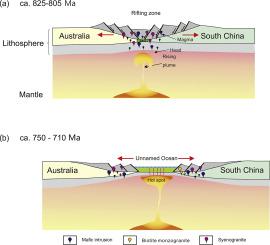Our official English website, www.x-mol.net, welcomes your feedback! (Note: you will need to create a separate account there.)
Origin and evolution of the Neoproterozoic Dengganping Granitic Complex in the western margin of the Yangtze Block, SW China: Implications for breakup of Rodina Supercontinent
Lithos ( IF 3.5 ) Pub Date : 2020-10-01 , DOI: 10.1016/j.lithos.2020.105602 Hao Zou , Leon Bagas , Xin-Yu Li , Hang Liu , Xiu-Wei Jiang , Yang Li
Lithos ( IF 3.5 ) Pub Date : 2020-10-01 , DOI: 10.1016/j.lithos.2020.105602 Hao Zou , Leon Bagas , Xin-Yu Li , Hang Liu , Xiu-Wei Jiang , Yang Li

|
Abstract A better understanding of the origin and evolution of widespread Neoproterozoic granites along the western margin of the Yangtze Block is important in locating the position of South China within the Rodinia Supercontinent, and the mechanism by which the supercontinent was fragmented. Published and our new detailed geochronological and geochemical data from the Dengganping Complex show that it formed during an extended magmatic event during the Neoproterozoic. This was during the emplacement of a fractionated ca. 815 Ma syenogranite, which was followed by partial melting during ca. 740 Ma and the emplacement of a biotite monzogranite. The geochemistry of the syenogranite indicates it is: (1) a peraluminous high-K type of granite; (2) calc-alkaline; (3) fractionated; (4) enriched in Th, U, Zr, Hf and LREE (LREE/HREE values of 5.3–9); (5) depleted in Nb and Sr; (6) has a negative Eu anomaly (δEu = 0.3–0.5); (7) has whole rock eNd(t) value of −0.7 to +0.5; (8) has zircon eHf(t) value of −1.7 to +5.2; and (9) has zircon 18O values ranging from 5.13 to 7.38‰. These characteristics are indicative of a source derived from the partial melting of crustal material. The biotite monzogranite is: (i) peraluminous calc-alkaline to high-K calc-alkaline; (ii) enriched in LREE (LREE/HREE = 9.9–14.6), Rb, Ba, Th and U; (iii) depleted in Nb and Ta; (iv) has weak negative δEu and δCe anomalies; (v) has whole rock eNd(t) value of between −3.2 and −1.8; has relatively high positive zircon eHf(t) values of +4.1 to +13; and has zircon 18O values ranging from 3.44 to 6.75‰. These features are indicative of partial melting of a juvenile mafic crust that might have experienced a high-temperature water-rock interaction. By comparing the geochronology of Neoproterozoic magmatic rocks along the faulted western margin of the Yangtze Block, it is suggested that the region was part of the Rodinia Supercontinent when it started to breakup during widespread rifting between ca. 825 and 710 Ma. We believe the fault zone formed in response to an opening ocean was induced by the presence of a mantle plume during this period.
中文翻译:

扬子地块西缘新元古代灯杆坪花岗岩杂岩的成因与演化:对罗迪纳超大陆解体的启示
摘要 更好地了解扬子地块西缘广泛分布的新元古代花岗岩的起源和演化,对于确定华南在罗迪尼亚超大陆内的位置以及超大陆分裂的机制具有重要意义。登干坪杂岩已发表和我们最新的详细地质年代学和地球化学数据表明,它是在新元古代的一次扩展岩浆事件中形成的。这是在一个分馏的约的就位期间。815 Ma syenogranite,随后在大约 815 Ma 期间部分熔化。740 Ma 和黑云二长花岗岩的就位。正长花岗岩的地球化学特征表明:(1)过铝质高K型花岗岩;(2) 钙碱性;(3) 分馏;(4) 富含Th、U、Zr、Hf和LREE(LREE/HREE值为5.3-9);(5) 贫铌和锶;(6) 有一个负的 Eu 异常(δEu = 0.3-0.5);(7) 全岩 eNd(t) 值为 -0.7 至 +0.5;(8)具有-1.7至+5.2的锆石eHf(t)值;(9) 锆石 18O 值范围为 5.13 至 7.38‰。这些特征表明来自地壳物质部分熔化的来源。黑云母二长花岗岩为: (i) 过铝钙碱性至高钾钙碱性;(ii) 富含轻稀土 (LREE/HREE = 9.9–14.6)、Rb、Ba、Th 和 U;(iii) 贫铌和钽;(iv) 具有弱的负δEu和δCe异常;(v) 全岩 eNd(t) 值介于 -3.2 和 -1.8 之间;具有相对较高的正锆石 eHf(t) 值,为 +4.1 至 +13;锆石 18O 值范围为 3.44 至 6.75‰。这些特征表明可能经历了高温水-岩相互作用的新生基性地壳部分熔化。通过比较扬子地块断层西缘新元古代岩浆岩的年代学,表明该地区是罗迪尼亚超大陆的一部分,当时它在大约 2000 年之间的广泛裂谷期间开始破裂。825 和 710 毫安。我们认为,为响应开放海洋而形成的断层带是由这一时期地幔柱的存在引起的。
更新日期:2020-10-01
中文翻译:

扬子地块西缘新元古代灯杆坪花岗岩杂岩的成因与演化:对罗迪纳超大陆解体的启示
摘要 更好地了解扬子地块西缘广泛分布的新元古代花岗岩的起源和演化,对于确定华南在罗迪尼亚超大陆内的位置以及超大陆分裂的机制具有重要意义。登干坪杂岩已发表和我们最新的详细地质年代学和地球化学数据表明,它是在新元古代的一次扩展岩浆事件中形成的。这是在一个分馏的约的就位期间。815 Ma syenogranite,随后在大约 815 Ma 期间部分熔化。740 Ma 和黑云二长花岗岩的就位。正长花岗岩的地球化学特征表明:(1)过铝质高K型花岗岩;(2) 钙碱性;(3) 分馏;(4) 富含Th、U、Zr、Hf和LREE(LREE/HREE值为5.3-9);(5) 贫铌和锶;(6) 有一个负的 Eu 异常(δEu = 0.3-0.5);(7) 全岩 eNd(t) 值为 -0.7 至 +0.5;(8)具有-1.7至+5.2的锆石eHf(t)值;(9) 锆石 18O 值范围为 5.13 至 7.38‰。这些特征表明来自地壳物质部分熔化的来源。黑云母二长花岗岩为: (i) 过铝钙碱性至高钾钙碱性;(ii) 富含轻稀土 (LREE/HREE = 9.9–14.6)、Rb、Ba、Th 和 U;(iii) 贫铌和钽;(iv) 具有弱的负δEu和δCe异常;(v) 全岩 eNd(t) 值介于 -3.2 和 -1.8 之间;具有相对较高的正锆石 eHf(t) 值,为 +4.1 至 +13;锆石 18O 值范围为 3.44 至 6.75‰。这些特征表明可能经历了高温水-岩相互作用的新生基性地壳部分熔化。通过比较扬子地块断层西缘新元古代岩浆岩的年代学,表明该地区是罗迪尼亚超大陆的一部分,当时它在大约 2000 年之间的广泛裂谷期间开始破裂。825 和 710 毫安。我们认为,为响应开放海洋而形成的断层带是由这一时期地幔柱的存在引起的。


























 京公网安备 11010802027423号
京公网安备 11010802027423号